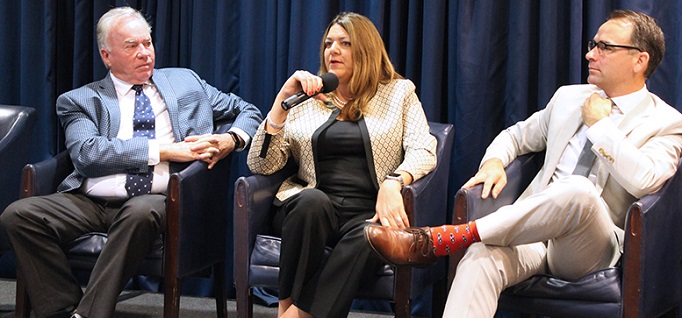Go ask ALICE
By Matthew Dembicki
October 30, 2019
Community college leaders and state officials to discuss the insights garnered from early College Promise programs.
When questioned about how community college programs are helping their students complete college, find good-paying jobs and better their communities, Glenn DuBois says to ask ALICE.
The chancellor of the Virginia Community College System is not referring to a person, but to a composite that reflects many of the adult students served by public two-year colleges: Asset Limited, Income Constrained, Employed — or ALICE. These are families who earn more than the federal poverty level yet struggle with basic household costs. (United Way of Northern New Jersey coined the term ALICE and manages a program to serve these individuals.)
In Virginia, roughly six out of 10 households still cannot afford to enroll in a degree program, DuBois said. And adults who do consider attending college are often discouraged by jargon, confusing college websites and courses that don’t fit into their schedules, he said. This is partly why enrollment continues to slide at community colleges, he added.
“Our menu doesn’t sync up to their needs,” DuBois said.
Principles for Promise
DuBois was on an Oct. 22 panel with other community college leaders and state officials to discuss the insights garnered from early College Promise programs, which typically cover two years of community college tuition for eligible students. But the conversation moved to broader issues affecting student success.
There are currently 320 varying Promise programs across the country, and 29 states have a Promise program to some degree, according to the College Promise Campaign. On Tuesday, Jobs for the Future (which hosted the panel discussion in Washington, D.C.) released a policy brief that includes four policy design principles for Promise programs:
- Advance student success
- Keep it simple
- Ensure sustainable and stable funding
- Allow for flexibility
Promise programs are important to provide college access to students, but they must be part of a larger design that ends with students having better economic mobility, said Madeline Pumariega, executive vice president and provost vice president for academic affairs at Tallahassee Community College in Florida.
In Virginia, conversations with state lawmakers are less about access and more about aligning programs to local workforce needs, DuBois said. The state’s community colleges are trying to help workers upgrade their skills quickly through noncredit programs, he said.
Too often, colleges keep to their business-as-usual model rather than adapting to what their student customers’ need, the panel said.
“Why do we still have a 16-week semester?” DuBois said. “What’s so holy about that?”
Businesses and for-profit schools aren’t waiting for community colleges to make those changes. A growing number of employers, such as Google, Amazon and Wal-Mart, are creating their own innovative training programs, Pumariega said. And for-profits continue to exist because they offer the flexible course hours and locations that students want, she added.
One of the reasons states such as Tennessee are focusing on adult learners is because there simply aren’t enough students in the K-12 pipeline to meet employers’ needs, said Jerre Maynor, director of student readiness and pathways at the Tennessee Department of Education. Although Tennessee is known for its Promise program, it’s had equal success with Tennessee Reconnect, which serves adults going to college.
In New York, the state-run Excelsior Scholarship program has allowed about 100 students to enroll at Rockland Community College, said President Michael Baston. But he noted that tuition is only one part of college costs. Too often, discussions about access don’t address living expenses, transportation, childcare and unexpected emergencies, which can derail many community college students, he said.
Pell for short-term programs
Several of the panel speakers said that they support extending Pell Grant eligibility for certain short-term training programs, which DuBois called “Workforce Pell.”
“This is the $1,000 that ALICE needs,” he said. “This is a game-changer.”
The House education committee last week introduced legislation to reauthorize the Higher Education Act (HEA) that would open Pell to short-term programs, as would the Senate education committee’s HEA proposal. Critics contend that it’s not known if extending Pell to these programs would work, but states already have the data that show short-term training increases incomes, improves job placements and more, DuBois said.
Baston added that workers benefiting from such grants could secure higher wages and can return to college later to upgrade their skills or continue toward a degree.
“This is a way the federal government can help folks in this situation,” he said.
There’s more to the story! Read the full article in CC Daily.



